Curriculum Research
The slides below outline six stages of the module design process. This page looks at stage three: "curriculum research".
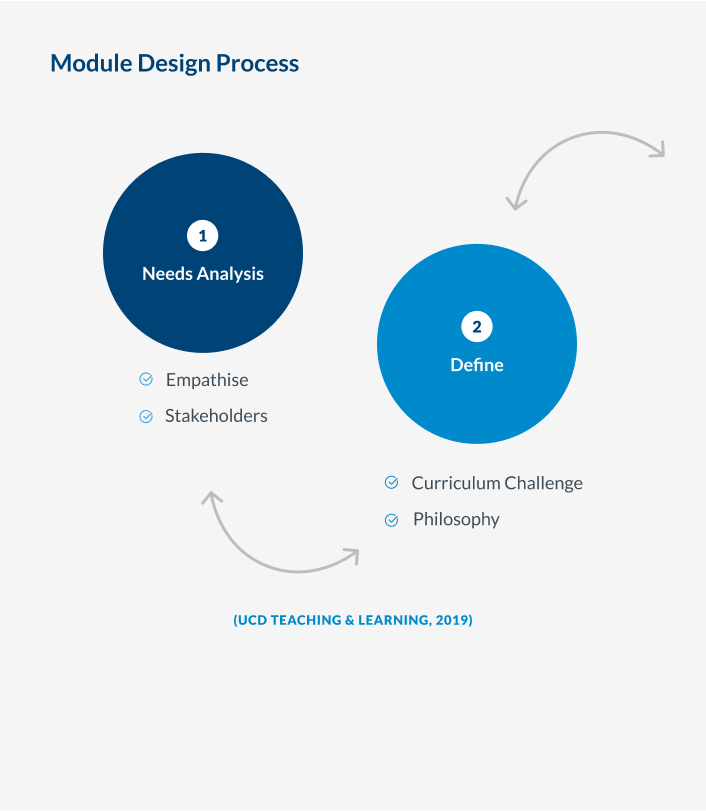
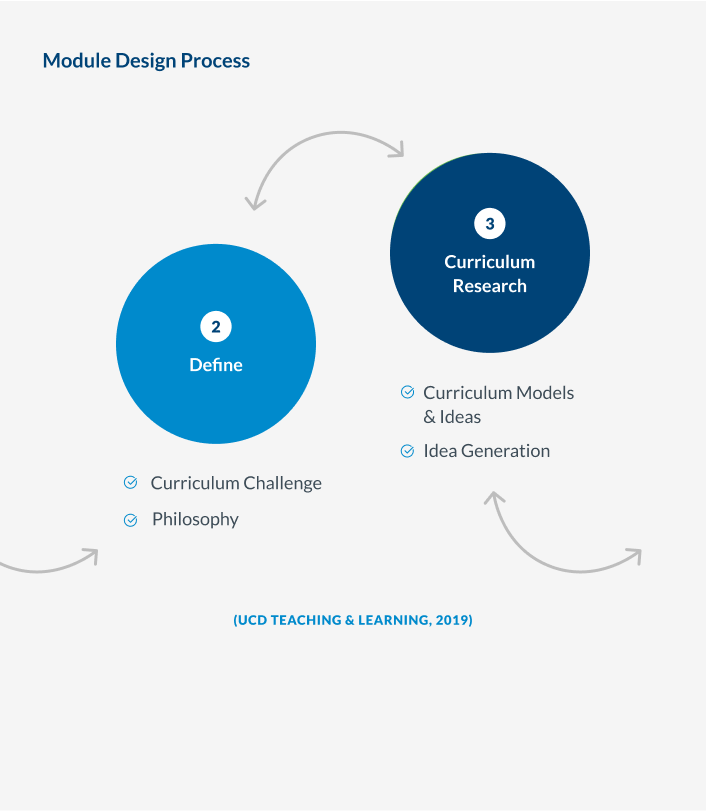
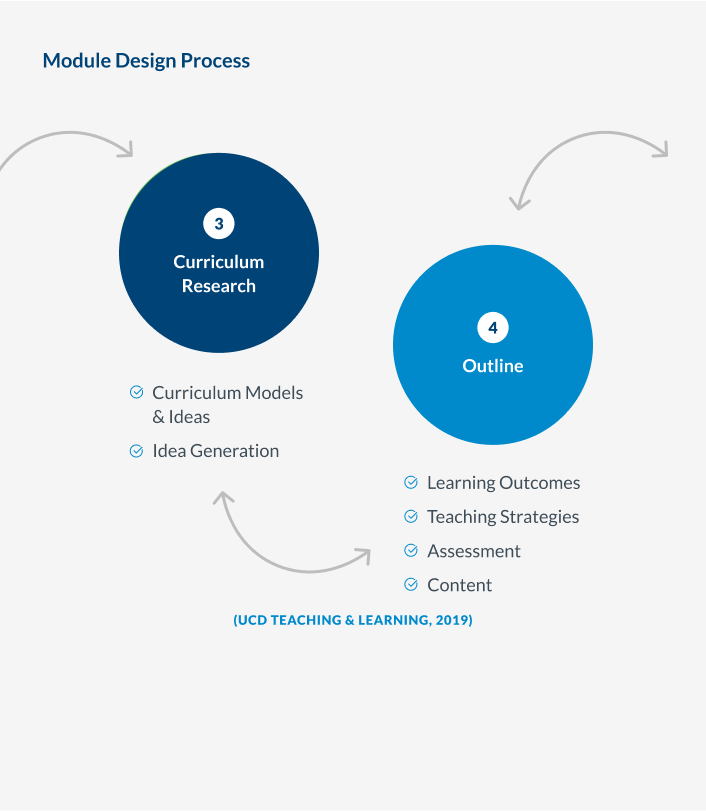
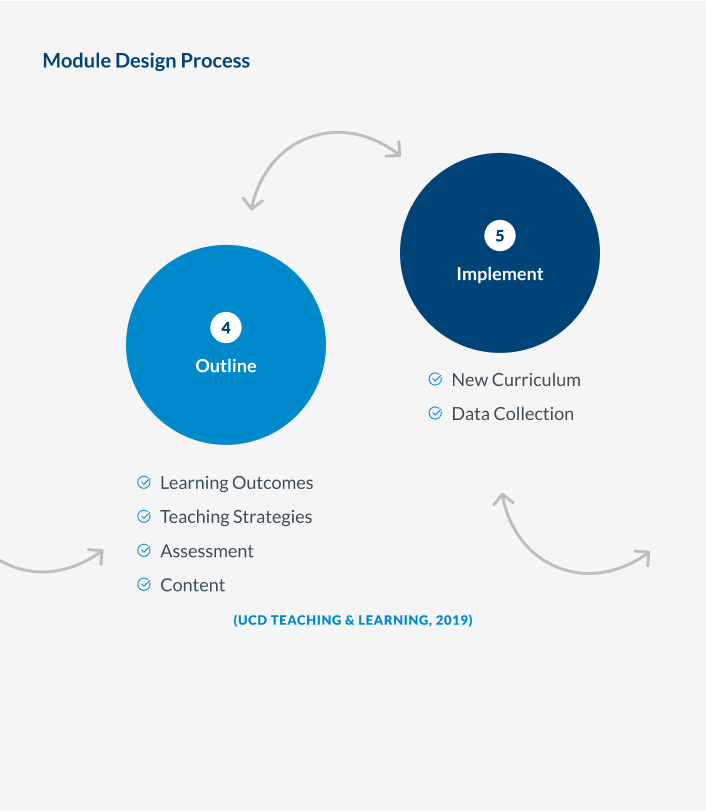
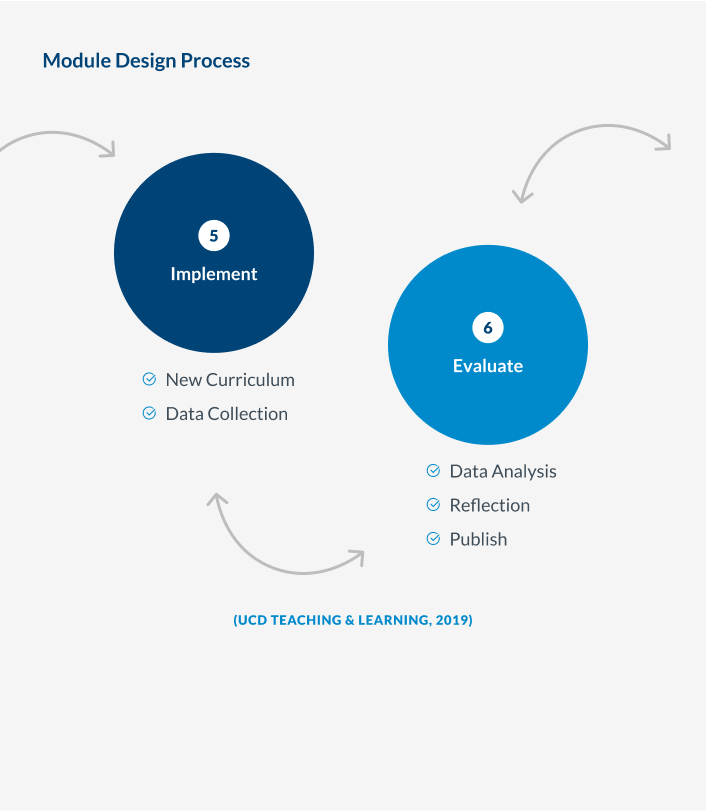
Question
The important module research question is: ‘If I had a blank sheet of paper and was starting this module from scratch, how would I design the module to promote student engagement, deep learning, critical thinking and research skills?’
Your curriculum research on this question may include researching current curriculum design and teaching approaches in your discipline alongside updating your knowledge of current curriculum and assessment policies in UCD. A key to this exercise is expanding your repertoire of curriculum models and ideas to choose the most appropriate ones for different modules.
Curriculum Models and Ideas
Curriculum Models
- Curriculum Alignment
- Universal Design
- Research-Focused Teaching
- Problem-based Learning
- The Engaged Curriculum
- Blended Learning
Curriculum Ideas
- Threshold Concepts
- Mindful Learning
Firstly, it is essential to decide what your learning outcomes are; in other words, what is important for students to learn in terms of knowledge, skills and attitudes. Learning outcomes are written from the students’ point of view. For example, ‘On completion of this module, students will be able to…’.
Further advice on writing learning outcomes and the literature on Guide to Taxonomies of Learning can provide guidance and ideas for the verbs used to describe different kinds and levels of learning.
Step 1 in curriculum alignment is writing learning outcomes.
Step 2 is designing specific teaching and learning activities to meet these outcomes.
Step 3 is designing assessments that align with the learning outcomes and the teaching and learning strategies.
Step 4 is selecting the content that will align with the learning outcomes, teaching and learning strategies and assessment strategies. This should always be your final step.
Aligning Curriculum Inputs: Learning Outcomes, Teaching and Learning Strategies, Assessment and Content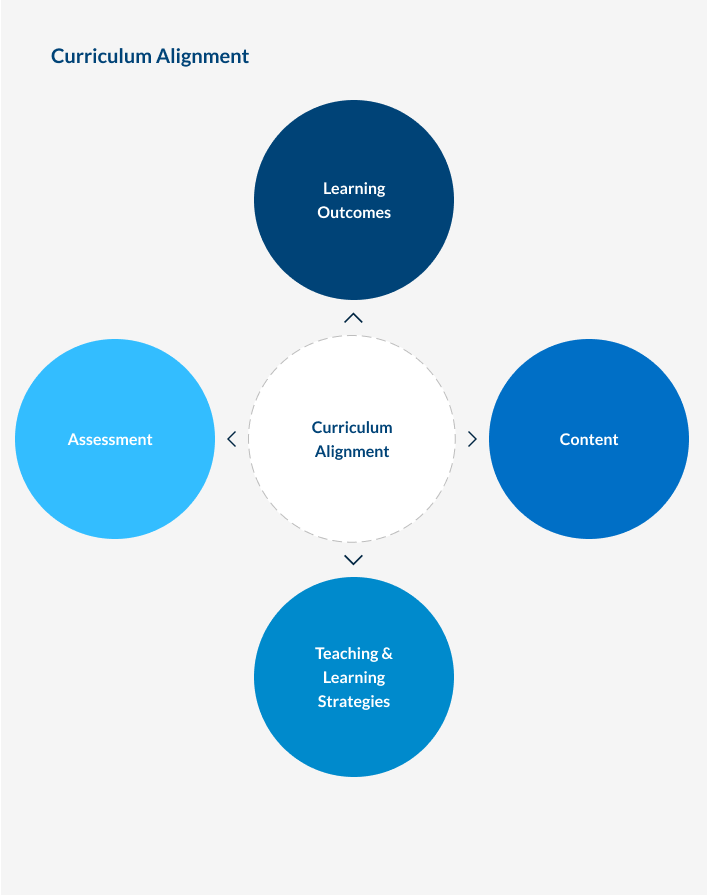
Adapted from Biggs (1996)
A Self-Directed Guide for Designing Courses for Significant Learning This graphic may be useful in helping you design a constructively aligned module.
Universal Design is a principle-based approach to designing university teaching and learning to meet the learning needs of all students. Higher education has become increasingly diverse. As we now strive to achieve widening participation of those students traditionally underrepresented in higher education and open our campuses to increasing numbers of international students, we must ensure that our teaching and learning develops in line with the student population. Universal Design (UD) offers us a framework that helps us to consider and embrace our diverse classrooms. Using the UD framework gives you the tools you need to consider all learners when planning and designing your curriculum.
At the core of Universal Design is a focus on variety, choice and feedback for students. Universal Design encourages a movement away from the traditional didactic, text-based classroom practices, and embraces a more dynamic, active and evolving multi-media classroom.
For additional practical information:
- Top Seven Tips for Inclusive Module Design outlines universal design strategies that you and all module coordinators can implement.
- Padden. L ., O’Connor, J., and Barrett, T (2017) Universal Design for Curriculum Design : Case studies from University College Dublin is another resource that provides more practical ideas and case studies on Universal Design.
In a research-intensive university you may be interested in finding out about more approaches to integrating research into your teaching and further developing the research capabilities of your students.
This Learning Through Research guide provides an important insight into the impact of research-teaching linkages on the Undergraduate student experience in UCD and the understandings and perceptions of the importance and relevance of research-teaching linkages amongst faculty.
Approaches to Research-Teaching Linkages: Some Examples provides useful examples of how to incorporate research into teaching.
The Connected Curriculum at University College London provides a framework as well as practical case studies and teaching materials for embedding research in teaching.
The Research Skills Development Framework can also help plan progressive development of research skills across modules.
Problem-based Learning as a Total Approach to Education (Barrett, 2017) 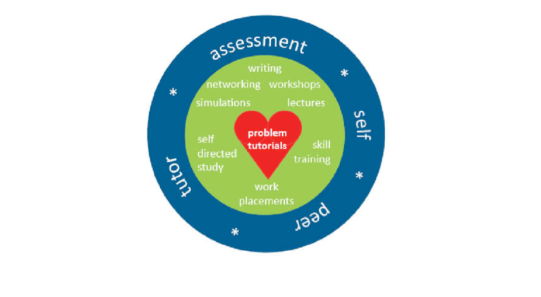
At the heart of problem-based learning, there are students working in small teams on real-life problems. Other curriculum inputs, such as lectures and workshops, are designed to link with the students’ work on these problems. The assessments are designed to be compatible with the work on problems and often combine self, peer and tutor assessment.
Understanding Problem-based Learning provides a brief overview of this methodology. A Practitioner’s Guide to Enquiry and Problem-based Learning: Case Studies from University College Dublin details problem-based learning modules complete with sample problems and assessment strategies. A New Model of Problem-based Learning: Inspiring Concepts: Practice Strategies and Case Studies from Higher Education provides a more detailed exploration of problem-based learning including sample problems from a range of disciplines, guidance on facilitating problem-based learning tutorials and developing students’ creativity and key skills.
The Engaged Curriculum (Kelly and Coate, 2005)
‘the test of an effective curriculum is ‘engagement’: Are the students individually engaged? Are they collectively engaged?’ (BARNETT AND COATE, 2005)
‘we deliberately want to leave open space for and, indeed, to encourage, creativity in curriculum design. … Rather than filling up the time with tasks intended to achieve stated objectives, the curriculum challenge has to be inverted to be understood as one of the imaginative design of spaces’ (BARNETT AND COATE, 2005)
The engaged curriculum focuses on engaging students in learning and teaching spaces that foster their ability to move to new ways of knowing, doing and being. Ask yourself:
- What do you want your students to know when they have completed the module?
- What do you want your students to be able to do when they have completed your module?
- What is important to develop in terms of ways of being for your students on this module?
- What is the right balance between, knowing, doing and being for your module?
- How do you plan to engage your students in knowing, doing and being?
- What type of spaces, learning processes and challenges will promote student engagement?
Blended Learning is a hybrid model that utilises the benefits of both face-to-face and online modes of learning. A substantial amount of the delivery (typically from 20% -79%) is online with the remaining portion delivered face-to-face. The blended model reduces the time spent in a more traditional face-to-face setting with some of the delivery, learning activities, feedback and assessment conducted online. Successful blended leaning relies on systematic planning with clear pedagogical links between face-to-face and online activities.
Many UCD programmes facilitate students to undertake internships, placements and other work-based learning experiences. There is a growing international trend in describing the range of these experiences, which can also include some on-campus projects, under the umbrella term of work-integrated learning (WIL). The emphasis on the word ‘integration’ highlights the importance of planning the integration of this experience with the other aspects of the students’ curriculum pre- and post this experience.
Threshold concepts are the key concepts in a discipline that are difficult to grapple with initially but are crucial to advancing in an understanding of the discipline.
Threshold Concepts: Students passing through a portal
Students understanding a threshold concept means they have passed through, a portal, a liminal space. They link and practice in new ways.
Threshold concepts are transformative, integrative, troublesome and irreversible.' (Meyer and Land, 2005).
.jpg)
Ask yourself:
- What are the threshold concepts you want to be at the centre of your module design?
- If you could only pick three threshold concepts for your module what would they be?
- What difference will a deep understanding of these concepts make to the learning of your students in this module and beyond?
Mick Flanagan Threshold Concept Website provides an extensive bibliography of both generic and discipline specific resources on threshold concepts.
Mindful learning combines students setting their intentions for learning with deciding to self-focus their attention on learning activities. Mindful learning also involves students switching their attention to appreciate different perspectives (Barbezat and Bushe, 2014, Langer, 2000). For example, students could set their attention for writing by completing a freewriting prompt, such as ‘The next thing I want to write about is…’, in silence for ten minutes.
Students could give their attention to reading by using a mindful reading process to read a short text, such as a poem, an abstract of a paper, or a brief for an assignment, together in class. There are different versions of mindful learning but all combine reading the text several times aloud. All involve a significant time of silence after each reading. There is an attention to individual words as well as the text. The process involves a sharing of what the text means to individuals with learning from the different perspectives of others in the class. In terms of switching their attention to appreciate other perspectives, students could review what they learned from others by writing in silence for five minutes at the end of class to a writing prompt, such as ‘The new things I learnt from members of my group today were…’
If you decide to integrate mindful learning activities into you module you may find these resources useful.
References
- Barbezat, D. and Bush M., (2014) Contemplative Practices in Higher Education: Powerful Methods to Transform Teaching and Learning. San Fransisco: Jossey Bass
- Barnett, R. and Coate, K. (2005) Engaging the Curriculum in Higher Education, Buckingham: SRHE and Open University Press.
- Barrett, T. (2017) A New Model of Problem-based Learning: Inspiring Concepts: Practice Strategies and Case Studies from Higher Education. Maynooth: All Ireland Society for Higher Education (AISHE)
- Biggs, J. (1996). Enhancing teaching through constructive alignment. Higher Education 32:347- 364.
- Langer, E. (2000) Mindful Learning Current Directions in Psychological Sciences 9 (1) pp. 220-223
- Meyer, J.H.F. and Land, R. (2005) Threshold concepts and troublesome knowledge (2): epistemological considerations and a conceptual framework for teaching and learning, Higher Education, 49 (3), 373-388